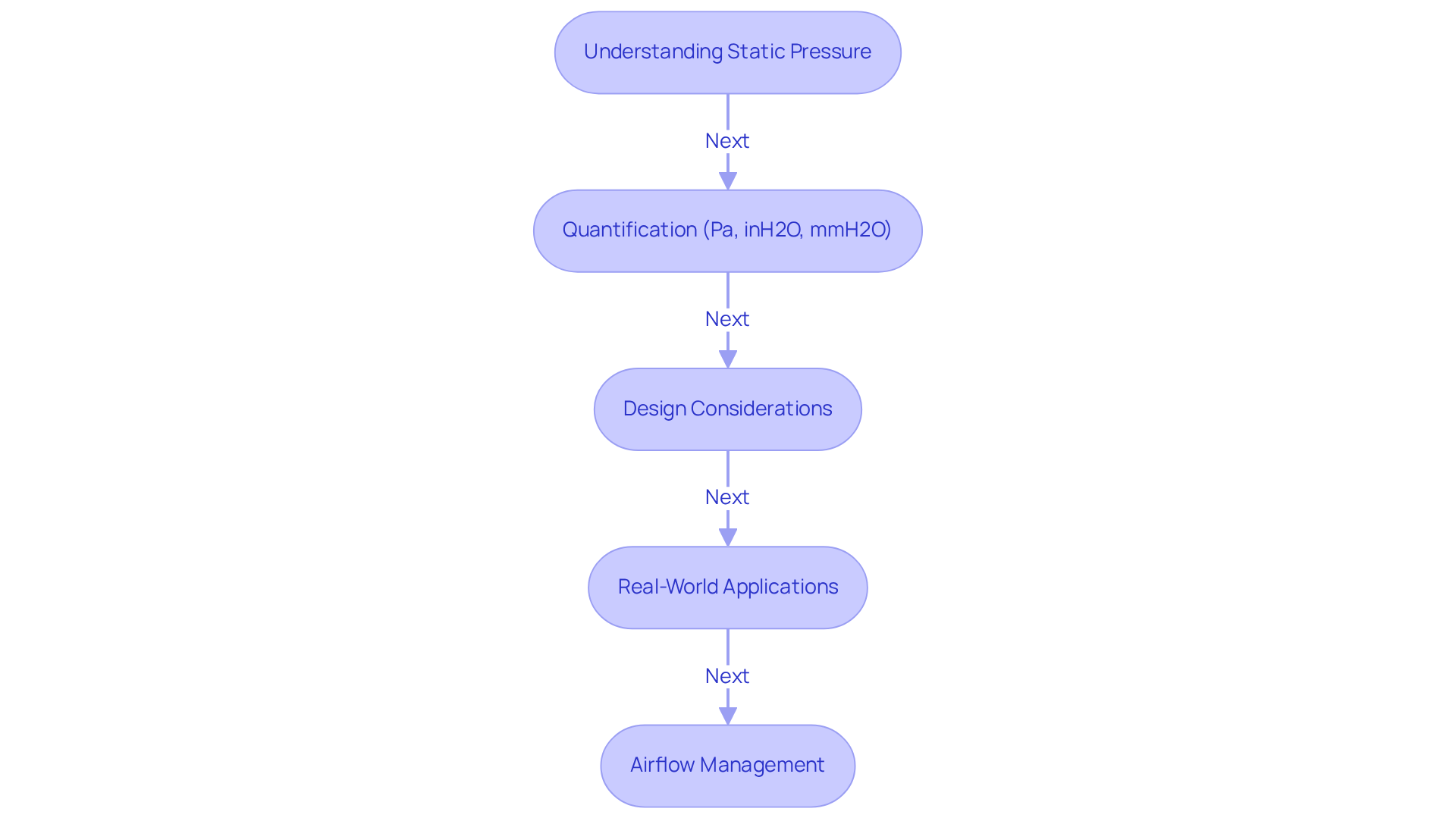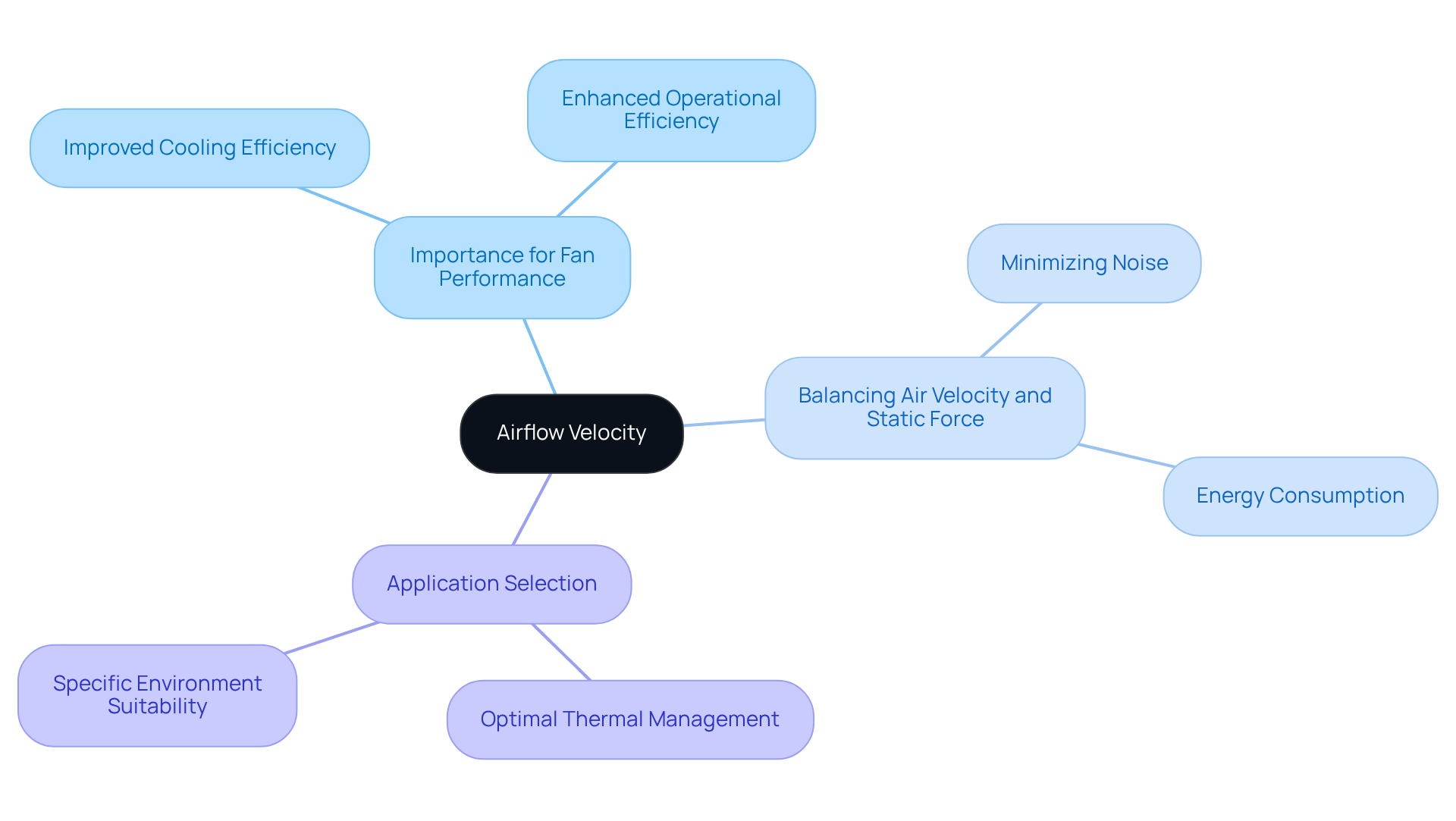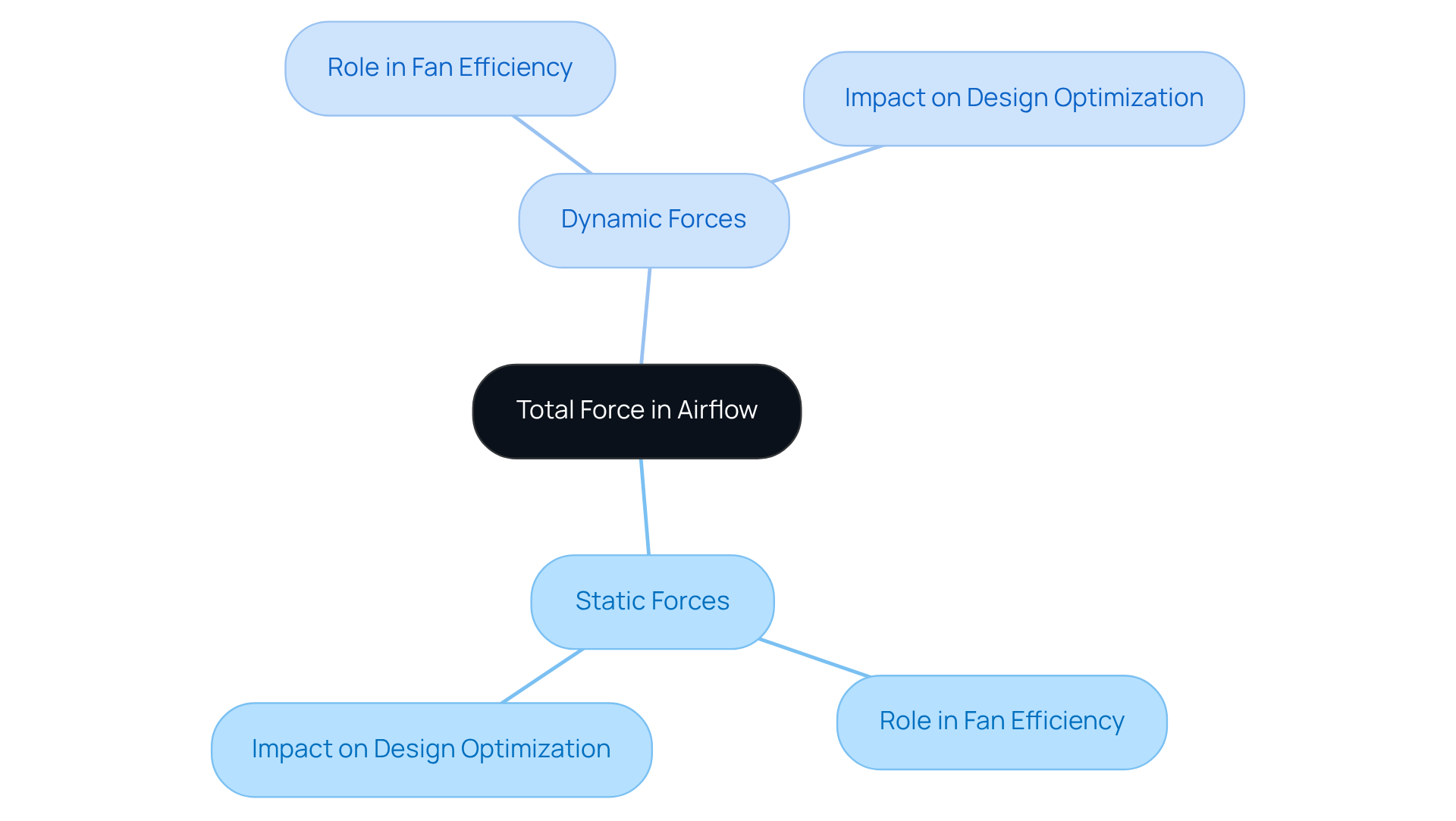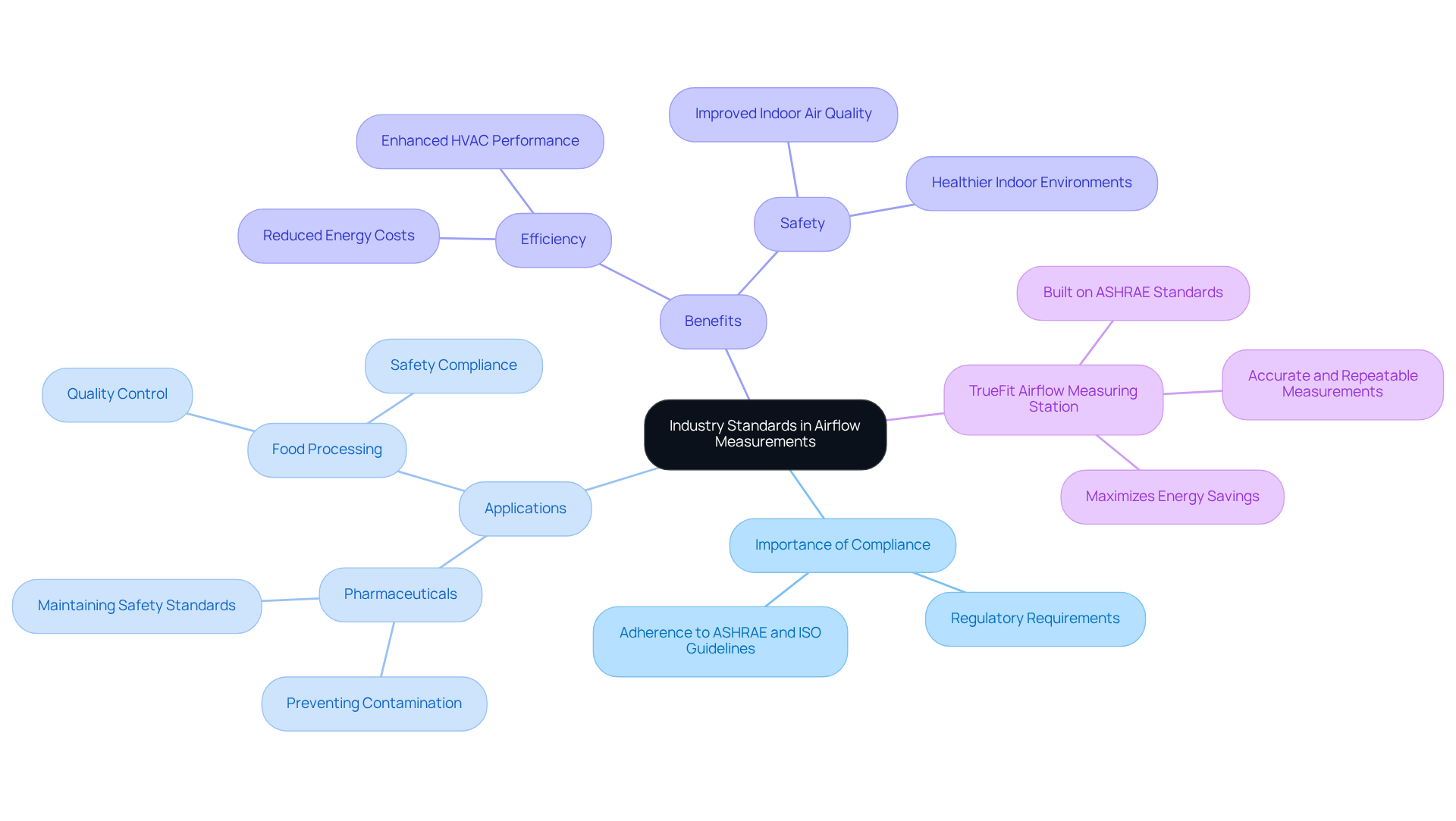Overview
Fan airflow pressures are critical measurements in engineering, typically quantified in six key units:
- Static pressure in Pascals
- Inches of water column
- Inches of mercury
- Airflow velocity in feet per minute
- Total pressure
- Differential pressure
Understanding these measurements is essential for engineers aiming to optimize fan performance and ensure efficient cooling systems. Each unit offers unique insights into airflow dynamics and operational efficiency, making it imperative for professionals in the field to grasp their significance. By mastering these metrics, engineers can enhance system performance and reliability.
Introduction
Understanding fan airflow pressures is essential for optimizing the performance of electronic systems, especially in cooling and power management applications. This article explores six key units used to measure these pressures, offering engineers vital insights to improve air movement efficiency. With various measurement units and their implications, how can engineers ensure they select the right tools and methods to achieve optimal airflow in their designs?
Gagner-Toomey Associates: Expert Solutions for Fan Airflow Measurement
Precise measurement of fan airflow pressures are usually measured in optimizing performance in electronic systems, particularly in cooling and power management applications. Gagner-Toomey Associates stands out by providing innovative solutions that empower engineers to achieve accurate air movement measurements. As the largest manufacturer of both standard and custom air-movers globally, Gagner-Toomey boasts a diverse portfolio of cooling solutions, including DC input tube axial fans and centrifugal blowers, specifically designed for various applications within the electronics industry.
Recent market trends indicate a growing demand for advanced air measurement tools, with the specialized cooling technologies sector experiencing a consistent growth rate of 15% annually. Industry experts, such as Yogesh Shinde, emphasize the critical role of fan management in this sector, noting that effective air management significantly enhances system performance and energy efficiency.
Gagner-Toomey’s commitment to excellence in customer service and product representation solidifies its status as a trusted partner for engineers in search of reliable measurement solutions. Understanding the differences between static force and airflow is also vital for engineers when selecting cooling equipment, ensuring optimal performance across various applications.

Static Pressure: Understanding Its Role in Fan Airflow Measurements
Static force represents the resistance that air encounters while traversing a network, playing a pivotal role in a fan’s ability to circulate air effectively. Engineers must account for static force in their designs, as it directly influences the performance of blowers against resistance from filters, ducts, and other components. This force is quantified in Pascals (Pa), inches of water column (inH2O), or millimeters of water column (mmH2O). For example, in electronic cooling systems, benchmarks for static force can vary significantly, with certain applications necessitating fans to sustain static forces exceeding 8 mmH2O to ensure optimal airflow. Misunderstandings about static force can lead to design inefficiencies; as one engineer aptly noted, “The unseen power that your fan must overcome is static force.”
Real-world scenarios illustrate how engineers have effectively tackled challenges posed by static force. In environments like 1U server racks, where high installation density can obstruct ventilation, engineers often opt for high static resistance units to ensure adequate cooling around closely packed components. Additionally, case studies reveal that while accessories such as filters can enhance reliability, they may also introduce significant losses, necessitating careful selection and placement to maintain efficiency in air movement.
Recent benchmarks indicate that static fans are essential in high-resistance environments, particularly in applications like medical devices and industrial systems, where precise air movement is critical. Some electronic applications require ventilation rates reaching up to 17,000 m³/h, underscoring the substantial air movement demands within the industry. Understanding the relationship between static force and air movement is vital for engineers aiming to boost fan efficiency, leading to energy savings and extended equipment lifespan. As Johann Tang remarked, “In this case, it can be safe to assume that the actual air flow will be about half of the fan’s maximum air flow, so select a fan that can produce double the required air flow.” Furthermore, it is crucial to recognize the inverse relationship between air movement and static force; as one increases, the other decreases. By accurately measuring and managing static force, engineers can significantly enhance the efficiency of their cooling systems.

Inches of Water Column: A Standard Measurement for Airflow Pressure
Inches of water column (inWC) is a standard unit used to measure static force in airflow systems. It quantifies the pressure exerted by a column of water that is one inch high. This measurement is crucial for engineers, as it indicates how fan airflow pressures are usually measured in order to assess fan performance and operational efficiency. Understanding that fan airflow pressures are usually measured in inWC is essential for selecting the right fan for specific applications, ensuring optimal circulation and cooling.
The importance of inWC extends to evaluating how fan airflow pressures are usually measured in various contexts. HVAC experts emphasize that accurate static readings are vital for maintaining system efficiency, as fan airflow pressures are usually measured in these readings. For example, a 10% decrease in fan RPM can result in a 10% reduction in airflow and a 19% drop in static pressure, demonstrating that fan airflow pressures are usually measured in inWC related to fan operation. The Fan Energy Index (FEI) is a valuable metric, indicating that an FEI greater than 1 signifies a fan’s efficiency compared to a baseline fan. This insight aids engineers in selecting energy-efficient blowers, ensuring optimal performance.
Moreover, the AMCA Standard 205 advises engineers to choose fans with no more than a 15-percentage-point deviation below the fan’s total peak efficiency, providing a benchmark for efficient fan selection. As we approach 2025, the relevance of inWC in fan performance, where fan airflow pressures are usually measured in, remains critical. With technological advancements and growing demands for energy efficiency, mastering the effective use of inWC will be essential for engineers striving to optimize cooling solutions in electronic applications, where fan airflow pressures are usually measured in.

Inches of Mercury: Measuring Fan Airflow Pressures
Inches of mercury (inHg) serves as a unit for measuring force, and fan airflow pressures are usually measured in this unit within HVAC systems. This measurement quantifies the force exerted by a column of mercury that stands one inch tall. While it may not be as commonly used as inches of water column, inHg holds significance in specific scenarios, particularly when dealing with high-pressure conditions.
Understanding that fan airflow pressures are usually measured in specific units is crucial for engineers, as it ensures that fans operate efficiently under varying tension conditions.
By grasping the implications of inHg, professionals can better design and implement systems that meet performance standards. This knowledge not only enhances operational efficiency but also contributes to the overall reliability of HVAC systems. Therefore, engineers must prioritize familiarizing themselves with this measurement, since fan airflow pressures are usually measured in order to optimize fan functionality.

Airflow Velocity: Key Measurement for Fan Performance
Airflow velocity, measured in feet per minute (FPM), is a critical metric that indicates the speed at which air travels through a network. Understanding this measurement is essential for assessing fan performance; higher velocities often translate to improved cooling efficiency. However, engineers face the challenge of balancing air velocity with static force to ensure that systems operate efficiently, minimizing noise and energy consumption.
Comprehending air velocity not only aids in evaluating fan capabilities but also plays a pivotal role in selecting the appropriate fan for specific applications. This selection is crucial for achieving optimal thermal management in various environments. By recognizing the interplay between airflow velocity and system performance, professionals can make informed decisions that enhance operational efficiency and effectiveness.

Total Pressure: Combining Static and Dynamic Measurements
Total force, defined as the sum of static and dynamic forces within a framework, is crucial for understanding airflow performance comprehensively. This measurement enables engineers to assess a fan’s capability to circulate air efficiently across various setups. By analyzing total force, engineers can pinpoint inefficiencies and refine designs, leading to improved performance. This integrative approach is vital for developing effective cooling solutions in electronic devices, where optimal airflow is essential for maintaining operational integrity.
Industry specialists emphasize that merging static and dynamic metrics is key to achieving enhanced fan efficiency. This highlights the significance of overall force in optimizing fan performance, particularly as we look toward 2025 and beyond. By focusing on total force, engineers can not only enhance the effectiveness of cooling systems but also ensure the longevity and reliability of electronic devices.

Differential Pressure: Assessing Fan Efficiency and Performance
Differential force serves as a vital metric that quantifies the force variation between two locations within a system, acting as a key indicator of fan efficiency. By analyzing differential force, engineers can assess how effectively a fan operates under varying load conditions, which is essential for optimizing fan selection and ensuring peak system performance. This measurement is particularly crucial in scenarios where air movement requirements fluctuate, as it directly impacts the fan’s ability to maintain consistent circulation and force levels.
In 2025, understanding the influence of differential forces on fan performance metrics is more critical than ever. For instance, research indicates that fans operating at elevated static levels often experience a decline in air movement efficiency, underscoring the need for precise differential assessments. Engineers emphasize that evaluating differential force not only aids in selecting the right fan but also assists in diagnosing existing systems, ensuring they meet the necessary air movement standards.
Evaluating fan performance through differential analysis often involves monitoring air movement in ventilation systems where static force varies significantly. Engineers routinely utilize differential measurement gauges to track performance metrics, allowing for real-time adjustments to optimize airflow. This proactive strategy can avert issues such as overheating or insufficient cooling, which are particularly vital in high-performance electronic applications.
Insights from engineers underscore the importance of differential force in fan performance evaluations. Many advocate for the regular monitoring of this parameter, as it offers valuable insights into the fan’s operational efficiency and signals when maintenance or replacement may be required. By prioritizing differential force analysis, engineers can enhance system reliability and performance, ultimately leading to more efficient designs and reduced energy consumption.

Anemometers: Essential Tools for Measuring Airflow
Anemometers are indispensable instruments for measuring wind speed and pressure across a variety of applications, particularly in the electronics sector. The latest models of anemometers in 2025 showcase advanced thermal types, engineered for complex environments. These devices not only assess air movement but also detect temperature variations, enhancing their functionality. Other prevalent types include vane anemometers, which employ spinning blades to gauge wind movement, and cup anemometers, celebrated for their simplicity and efficiency in outdoor conditions.
Choosing the right anemometer is vital for obtaining accurate measurements, as fan airflow pressures are usually measured in specific units. Engineers must consider several factors, including the specific application, the expected air movement range, and the environmental conditions. For instance, constant-temperature anemometers are preferred for their high precision in measuring both gas and liquid flows, making them ideal for sensitive electronic devices. Conversely, constant-power anemometers, while easier to use, may lack precision due to their absence of feedback mechanisms.
Accuracy statistics reveal that constant-temperature anemometers can achieve measurement uncertainties as low as 1%. This level of precision is crucial for applications requiring meticulous air movement control, particularly in HVAC systems where fan airflow pressures are usually measured in order to maintain optimal circulation, which is essential for ensuring adequate ventilation and improving indoor air quality. In practice, engineers often select specific anemometers based on their unique needs; for example, a thermal anemometer may be chosen for HVAC applications, while a vane anemometer could be employed in outdoor settings to measure wind speeds.
Feedback from engineers highlights the significance of selecting the appropriate anemometer for specific applications. One engineer noted, “Choosing the right anemometer is like selecting the correct tool for a job; it directly impacts the accuracy and effectiveness of our air movement measurements.” This statement underscores the critical role anemometers play in optimizing air movement in electronic devices and ensuring safety and efficiency across various environments, including managing air circulation to prevent hazardous situations in workplaces.

HVAC Systems: The Importance of Accurate Airflow Measurements
Precise air movement measurements, which are essential for the efficiency of HVAC systems, are often represented in terms of fan airflow pressures, which are usually measured in various units. This directly influences heating, cooling, and ventilation performance. Engineers must diligently monitor air movement to ensure optimal comfort levels and energy efficiency. Recent trends in 2025 highlight the integration of advanced measurement technologies, such as the TrueFit Airflow Measurement System. This system adheres to ASHRAE standards and provides precise, repeatable measurements across various equipment types, ensuring compliance and operational efficiency.
HVAC experts recognize that maintaining energy efficiency through effective air circulation monitoring can lead to significant cost reductions. For instance, after improving ventilation in a residential setting, homeowners reported a 30-50% decrease in heating expenses, illustrating the financial benefits of accurate air management. Furthermore, precise air measurement is crucial for compliance with regulatory standards, particularly in industries where it is important to understand air quality, such as pharmaceuticals and food processing.
A notable case involved Jon and Kelly’s renovation, which transformed their home into a highly efficient, all-electric setup. This project not only improved comfort by eliminating cold spots but also aimed for a Net Zero energy footprint. It demonstrates how strategic air movement management can enhance both performance and sustainability. Jon emphasized the importance of HVAC units that deliver the exact level of heating or cooling for extended periods, further highlighting that precise air movement measurements are essential.
In conclusion, understanding and applying precise air movement measurements is vital for HVAC engineers. It ensures compliance and operational efficiency while significantly enhancing customer satisfaction by creating comfortable and energy-efficient environments. Engineers are encouraged to embrace advanced measurement technologies and consistently monitor air movement to improve system performance and achieve substantial energy savings.

Industry Standards: Ensuring Consistency in Airflow Measurements
Adhering to industry standards for ventilation measurements is vital for achieving consistency and reliability across various applications. The ASHRAE and ISO guidelines serve as essential frameworks for evaluating air movement and pressure, enabling engineers to uphold quality and compliance in their designs. By implementing these standards, professionals can ensure their systems not only meet performance expectations but also satisfy regulatory requirements.
This compliance is particularly critical in sectors such as pharmaceuticals and food processing, where precise air control is necessary to prevent contamination and maintain safety standards. Moreover, accurate ventilation measurement can significantly enhance HVAC efficiency, leading to reduced energy costs and improved indoor air quality. Consequently, healthier indoor environments foster increased productivity and satisfaction among both employees and customers.
The TrueFit Airflow Measuring Station exemplifies this commitment to precision, delivering accurate and consistent measurements of air movement in accordance with ASHRAE standards. This framework not only boosts HVAC operational efficiency but also maximizes energy savings, showcasing the tangible advantages of adhering to these industry standards.
Regular airflow monitoring is equally important, as it optimizes system performance and mitigates inefficiencies. This further underscores the necessity of compliance with ASHRAE and ISO guidelines, ensuring that organizations can maintain high standards in their operations.

Conclusion
Understanding the various units of measurement for fan airflow pressures is essential for optimizing performance in electronic systems. Accurate airflow measurement significantly impacts cooling and power management applications. Companies like Gagner-Toomey Associates play a crucial role in providing innovative solutions for engineers seeking reliable measurement tools.
Key points include:
- The importance of static pressure in fan performance.
- The standard units of inches of water column and inches of mercury for measuring airflow.
- The critical metrics of airflow velocity and total pressure.
- The significance of differential pressure in assessing fan efficiency.
- The essential role of anemometers in measuring airflow accurately.
Each of these elements contributes to a comprehensive understanding of airflow management, vital for enhancing system performance and energy efficiency.
As we become increasingly reliant on advanced cooling technologies, engineers must prioritize precise airflow measurements to ensure optimal system functionality and compliance with industry standards. By leveraging innovative measurement techniques and adhering to established guidelines, professionals can improve the performance and reliability of their systems while contributing to energy savings and sustainability in electronic applications. Embracing these insights empowers engineers to make informed decisions that enhance both operational efficiency and overall effectiveness in their designs.
Frequently Asked Questions
What is the primary focus of Gagner-Toomey Associates?
Gagner-Toomey Associates specializes in providing innovative solutions for precise measurement of fan airflow pressures, particularly in cooling and power management applications within the electronics industry.
What types of cooling solutions does Gagner-Toomey offer?
Gagner-Toomey offers a diverse portfolio of cooling solutions, including DC input tube axial fans and centrifugal blowers, designed for various applications in the electronics sector.
What is the current market trend regarding air measurement tools?
There is a growing demand for advanced air measurement tools, with the specialized cooling technologies sector experiencing a consistent growth rate of 15% annually.
Why is static force important in fan airflow measurements?
Static force represents the resistance that air encounters while moving through a system, and it directly influences a fan’s ability to circulate air effectively against resistance from filters, ducts, and other components.
How is static force quantified?
Static force is quantified in Pascals (Pa), inches of water column (inH2O), or millimeters of water column (mmH2O).
What challenges do engineers face regarding static force in electronic cooling systems?
Engineers must account for static force to ensure optimal airflow, particularly in high-density environments like 1U server racks, where high static resistance units may be required for adequate cooling.
What is the significance of inches of water column (inWC) in airflow systems?
Inches of water column is a standard unit for measuring static force in airflow systems, indicating the pressure exerted by a one-inch high column of water, which is crucial for assessing fan performance and operational efficiency.
How does fan RPM affect airflow and static pressure?
A 10% decrease in fan RPM can lead to a 10% reduction in airflow and a 19% drop in static pressure, highlighting the importance of accurate static readings for maintaining system efficiency.
What is the Fan Energy Index (FEI)?
The Fan Energy Index is a metric indicating a fan’s efficiency compared to a baseline fan, where an FEI greater than 1 signifies better efficiency.
What does the AMCA Standard 205 recommend for fan selection?
The AMCA Standard 205 advises engineers to choose fans with no more than a 15-percentage-point deviation below the fan’s total peak efficiency to ensure efficient fan selection.

